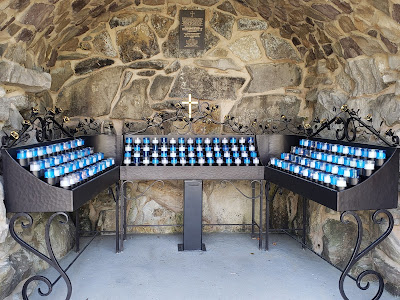HISTORY OF OUR LADY OF THE MIRACULOUS MEDAL
On 18 July 1830, then Sister Catherine Laboure was living in a Sisters of Charity of St. Vincent de Paul convent in Paris, when one night she claimed to have been awakened by a young child who appeared at her bedside. The child called for her to follow, saying “The Blessed Virgin Mary is waiting for you.” Sr. Catherine got up and followed the child to the Chapel altar, and after a time spent kneeling at the altar rail, the Blessed Mother appeared. As told to her priest confessor Fr. Aladel afterward, Sr. Catherine says Mary revealed certain calamities that were to occur in the future and gave her instructions on how to act in the times of trial ahead. In addition, Sr. Catherine stated Mary expressed to her that she had an important mission for her which would be revealed on a future date. Mary also instructed her to share this information with no one other than her confessor.
On 27 Nov. 1830, Sr. Catherine experienced another and final apparition at the altar. She said Mary appeared to her standing on a globe with a snake underneath it (Note- see Genesis Ch. 3 and Revelations Ch.12 for the Biblical roots of the symbolism), and Mary holding a cross with a smaller globe on top of it. Sr. Catherine attested that the small globe quickly disappeared but then she noticed Mary’s hands being lifted which had jewels on them, some of which shined rays of light, while others did not. Mary explained that the rays symbolized graces given by God and the jewels with no rays symbolized unclaimed graces offered by God. During this apparition, Mary's appearance was outlined in an oval frame with writing inscribed over her that read: “Oh Mary conceived without Sin, pray for us who have recourse to thee.”
Later, the frame revolved, revealing on the back the letter M surmounted by a cross with a crossbar underneath; and beneath that, the Sacred Heart of Jesus surrounded by a crown of thorns, and the Sacred Heart of Mary pierced by a sword. After this was revealed, Sr. Catherine stated Mary told her to have a medal made in this design and have it spread among the faithful to wear, as it would provide them with special graces.
Fr. Aladel was informed of this immediately but observed
Sr. Catherine for 2 years before relaying this incident to the archbishop and
requesting production of the medals. He did not even reveal her identity to the
archbishop. Long story short, the Medals were made and became a huge success,
even without Sr. Catherine’s identity being revealed. Sr. Catherine labored in
the convent for 40 years in anonymity, only revealing her connection to the Medal shortly before her death in 1876. In 1933 her body was examined and found
to be incorrupt, which is understood by the Catholic Church to be a sign of Sainthood.
She was canonized a saint in 1947 and her incorrupt remains are still visible
today.
Many miracles were attributed to the medals leading them to
be called “The Miraculous Medal.” Accounts of some of the most well-known miracles
can be found here:
Of all the miracles attributed in part to the medal, my favorite is the medal’s role in the conversion of an anti-Catholic Orthodox Jew named Alphonse Ratisbonne, who hated Catholicism, especially due to his brother’s conversion. Then, through an odd sequence of events in which he happened to be in possession of the Miraculous Medal, something miraculous happened, that you can read about here:
https://www.americaneedsfatima.org/Conversions/the-conversion-of-alphonse-ratisbonne.html
VISITING THE CHURCH
On my visit last Friday, I encountered a wonderful tour guide named Robbie who is a walking encyclopedia of the Church and Shrine area generally. He explained the historical development of the Church, which includes within it the actual chapel dedicated as a shrine to the Miraculous Medal. The connection to the medal comes from the fact that the founders of the Church and Seminary were Vincentians, as was Sr. Catherine, a Roman Catholic society established by St. Vincent de Paul. This altar was dedicated in 1930:















































0 comments:
Post a Comment